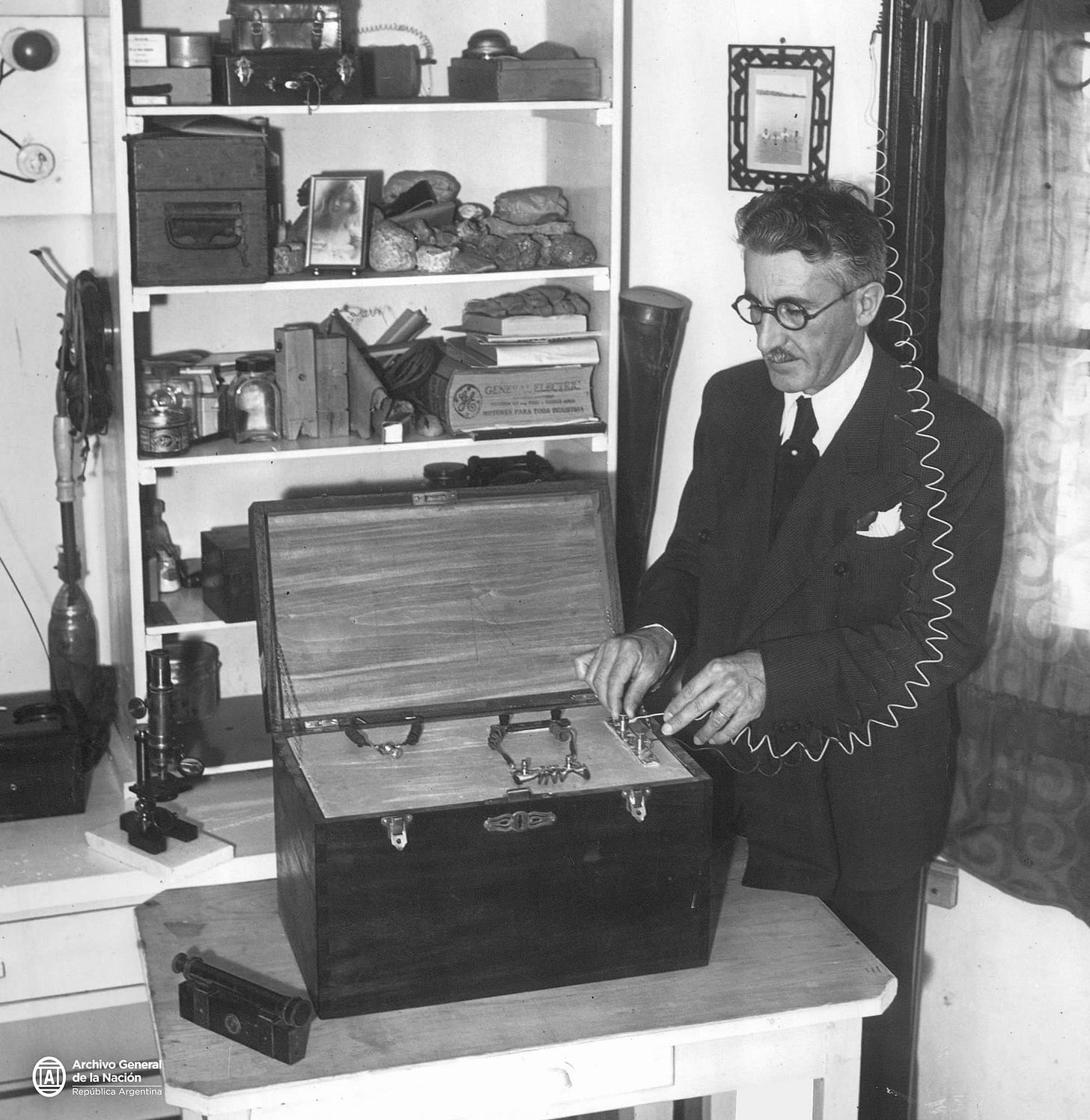The Rainmaker
In the long and rich history of snake oil salespersons and dubious visionaries, a hidden champion begs to be brought to light: Juan Baigorri Velar. Dubbed “the rainmaker” by his admirers and skeptics alike, Baigorri claimed he could manipulate the weather, summoning rain at will with his mysterious invention. Baigorri’s tale sits comfortably alongside a long lineage of charlatans who have sold dreams and delivered little more than vaporware.
Born in 1891 in Concepción del Uruguay, Argentina, Baigorri Velar’s early years were unremarkable. He trained as a geophysicist, studying in Europe and gaining an education in atmospheric sciences1. But his return to Argentina in the 1930s marked a shift from conventional science to something closer to showmanship. Baigorri began touting an invention that, by his own account, could bring rain anywhere, anytime. This device, he claimed, manipulated “electromagnetic fields” (sic) to influence atmospheric moisture and induce precipitation.
Of course, the scientific community demanded proof. Baigorri, an elusive figure, refused to disclose the inner workings of his gizmo, citing fears of intellectual theft. Classic. What he did offer, however, were public demonstrations that would boost his legend. He became more and more famous, even having some famous children's folk songs altered after him:
Que llueva, que llueva,
Baigorri está en la cueva.
Enciende el aparato
y llueve a cada rato
Baigorri’s so-called rainmaking machine was described as a modest, box-like contraption, the kind of device that might not look out of place at a magician’s show. It was small, unassuming, and wrapped in a fog of technical mystery. Baigorri’s confidence in its efficacy, however, was anything but small. He traveled to drought-affected regions, promising rain to desperate farmers, and, from time to time, he appeared to deliver.
One of his most famous stunts took place in Santiago del Estero, a province devastated by drought. With crops failing and livestock dying, the region’s people had little to lose by listening to the claims of our friend. Baigorri declared that he could bring rain within days. Miraculously—or coincidentally—heavy rainfall followed. Crowds hailed him as a savior, while skeptics dismissed him as a salesman who had simply gotten lucky.
Baigorri’s rise to fame followed a familiar pattern: make bold, unverifiable claims and exploit some pressing need. It’s the same playbook used by countless sellers of “revolutionary” solutions throughout history. From Charles Hatfield, the American “rainmaker” who allegedly used secret chemicals to coax rain from the sky in the early 20th century, to modern startups that promise disruptive technologies only to deliver nothing, but rake millions of investors’ money in the process. There isn’t precisely a drought of gullible investors; see how Elizabeth Holmes managed to swindle Henry Kissinger, a war criminal who closely worked for decades with the CIA overthrowing governments around the world. You wouldn’t think that man was the easiest to fool. And yet she did lure him into the Theranos rainmaking nonsense.
What makes figures like Baigorri so enduring is their ability to tap into sensitive human needs. Argentina in the 1930s and 1940s was no stranger to drought and agricultural crises, and the rural poor were eager for any solution, no matter how improbable. For those communities, Baigorri wasn’t just a man with a mysterious machine; he was a symbol of hope.
Hope, as Baigorri demonstrated, is an easily exploitable commodity. His rainmaking device, much like modern vaporware, was always just convincing enough to keep people believing. He offered no verifiable data, no detailed explanations, and no repeatable results. Instead, he relied on the psychological power of belief: if it rained after he flipped a switch, then surely he had made it happen.
To his credit, Baigorri never shied away from the spotlight. He accepted challenges from skeptics, including a particularly memorable one in Buenos Aires, where he promised rain in the Villa Luro neighborhood. Rain did fall, and Baigorri walked away triumphant.
The scientific community remained skeptical. Meteorologists pointed out that his successes could be attributed to chance or seasonal patterns. Even the timing of his demonstrations, critics noted, often coincided with forecasted precipitation. Yet Baigorri doubled down, dismissing detractors as envious or ignorant. His refusal to allow independent testing of his device only added to the skepticism surrounding him.
As the years went on, Baigorri’s star began to fade. His refusal to provide evidence alienated even his supporters. The world moved on, leaving Baigorri to languish in obscurity. He died in 1972, taking the secrets of his rainmaking device to the grave.
Baigorri’s story, however, did not die with him. He remains a symbol of ingenuity or credulity, depending on one’s perspective. Like so many miracle solutions before and after him, it was an invention that promised the world and delivered little more than a good story.
Baigorri’s story is not unique, even if the technology he claimed to create was. His rise and fall seem to mirror the trajectory of countless other would-be disruptors. Today’s world is rife with similar figures promising revolutionary products that don’t exist and will never materialize. Self-proclaimed inventors hawking untested solutions to global problems. What Baigorri’s tale reveals is not just the allure of bold promises but also the cyclical nature of human gullibility ∎.
Several details about Baigorri’s background are doubted as false, so it’s not entirely clear where he studied and what exactly.

